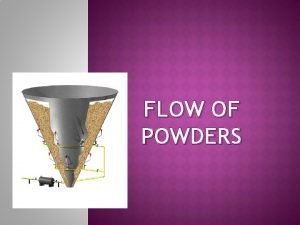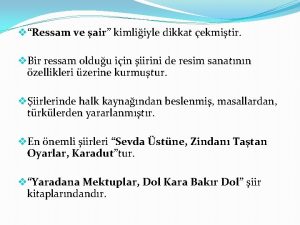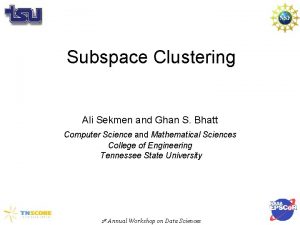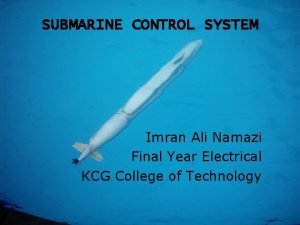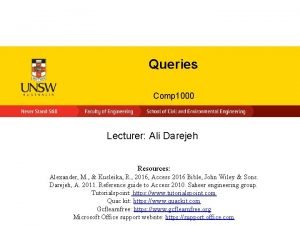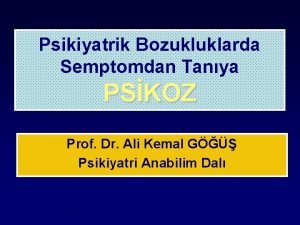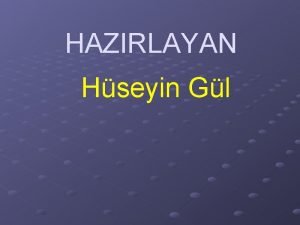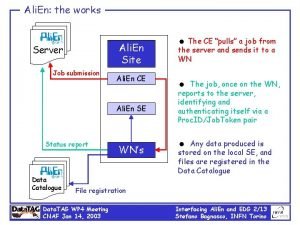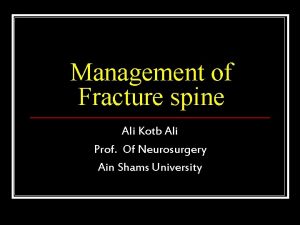Ali Flow Summary Importance of Flow in H












![“True” & Observable Flow 360 MC events/bin with Multiplicity [50 10. 000] π+/Elliptic Flow: “True” & Observable Flow 360 MC events/bin with Multiplicity [50 10. 000] π+/Elliptic Flow:](https://slidetodoc.com/presentation_image/0834930f053ef08d37f1084fe1f61831/image-13.jpg)
![No Flow (MC) 360 MC events/bin with Multiplicity [50 10. 000] π+/No Flow: v No Flow (MC) 360 MC events/bin with Multiplicity [50 10. 000] π+/No Flow: v](https://slidetodoc.com/presentation_image/0834930f053ef08d37f1084fe1f61831/image-14.jpg)








![Integrated Flow (MC) 360 MC events/bin with Multiplicity [50 10. 000] π+/- , T=100 Integrated Flow (MC) 360 MC events/bin with Multiplicity [50 10. 000] π+/- , T=100](https://slidetodoc.com/presentation_image/0834930f053ef08d37f1084fe1f61831/image-23.jpg)
![No Flow (MC) 360 MC events/bin with Multiplicity [50 10. 000] π+/- , T=100 No Flow (MC) 360 MC events/bin with Multiplicity [50 10. 000] π+/- , T=100](https://slidetodoc.com/presentation_image/0834930f053ef08d37f1084fe1f61831/image-24.jpg)








- Slides: 32

Ali. Flow

Summary • Importance of Flow in H. I. C. • STAR approach • Flow Analysis in ALICE • Observable Flow • Resolution & “true” vn • Ali. Flow code (& work • Needs in progress)

Flow (in brief) In (non central) HI collisions a spatially asymmetric source is formed. . . z Y b b e lan X And evolves. . . b ion P t ac e R t 0 tf. o. → pressure gradient → momentum anisotropy Fourier expansion of the momenta distribution Azimuthal anysitropy: Elliptic Flow d. N/dφ spatial anisotropy 2 v 2

Flow allow us to investigate the E. O. S. of the bulk M. Gyulassy: “QGP stands on 3 legs, & the 1 st one is flow” Py Integrated Flow is a relatively easy measurement (does not need a huge data sample): we can measure from the 1 st day of A. L. I. C. E. . and we almost have the code: Px • S. T. A. R. experience is summarized in their code (St. Flow) St. Flow package is a collection of C++ classes & methods • We just need to “translate” it for Ali. Root (Ali. Flow) Decouple it from the STAR enviroment done Ali. Root Decouple it from St. Root package done Plug it into Ali. Root it works Optimize it for the ALICE enviroment to do

Strategy

Data Production chain LHC Generator Ali. Root Ge. VSim Geometry Detectors Geant Classes 3 Event Summary Data Ali. ESD Ali. Root macros Ali. Flow. Interface Ali. Flow. MCface cuts ROOT TObject Ali. Flow. Event M. C. simulation Kine. Tree Information that are useful for flow study are summarized in this ROOT object

Flow. Analysis Ingredients What do we need for Flow Analysis: Precise measure of the tracks’ azimuthal angle φ An estimate of the reaction plane angle Ψ : • it’s not known from the geometry of the collision (that is unmeasurable) • can be estimated from φ distribution itself (tracks escape with a favourite direction) Estimate of our precision Resolution (from sub-events)

Flow. Analysis chain Flow Analysis runs over Ali. Flow. Events Ali. Flow. Event info Weights § Tracks Array Flattening Distribution V 0 s Array Sub. Events Q vector - ΨRP QA-QB & ΔΨSub * Resolution Observable vn Correlation # “True” vn & uncertainties

§ Flattening Weights φ distribution of all the tracks of all events is flat . . . if we have a perfect detector d. N/df Flow_Phi_TPC_flat In this kind of analysis (where φ plays a central role), we should “flatten” our angular distribution as much as possible! • detector holes & cracks • ≠ tracking efficiency • other systematics • . . . 0 f 2 p Weighting Histograms to correct detector asymmetries are carryed out automatically. 1 st run: Flow. Phy. Wgt. hist. root 2 nd run: each track gets a wheight wi (see Qvector & Ψ. . . ).

Auto. Correlation # When correlating particle to the Reaction Plane Ψr we should be carefull not to correlate each particle with itself : • Q vector is calculated once. . . • Then for each track i we get Ψ : Flow Values are averaged over all the particles in each p. T (ŋ) windows

* Resolution What we see is not the “true” Reaction Plane Ψr (we build up the Q vector from the tracks we’re able to see) Flow Values need to be corrected to take in account our resolution in determining the reaction plane: Resolution can be estimated from sub-events ( Poskanzer, Voloshin - Phys. Rev. C 58 (1998) 1671. . . ) : Where A & B are two (random or ŋ) sub-events.

Results (MC & reconstructed ESD) 100 events with 1400 π+/-, 600 p ; Elliptic Flow: v 2 = 0. 2 Kine. Tree Ali. ESD
![True Observable Flow 360 MC eventsbin with Multiplicity 50 10 000 πElliptic Flow “True” & Observable Flow 360 MC events/bin with Multiplicity [50 10. 000] π+/Elliptic Flow:](https://slidetodoc.com/presentation_image/0834930f053ef08d37f1084fe1f61831/image-13.jpg)
“True” & Observable Flow 360 MC events/bin with Multiplicity [50 10. 000] π+/Elliptic Flow: v 2 [0. 01 0. 3] v 2=0. 3 v 2=0. 2 v 2=0. 15 v 2=0. 1 v 2=0. 05 v 2=0. 02 v 2=0. 01
![No Flow MC 360 MC eventsbin with Multiplicity 50 10 000 πNo Flow v No Flow (MC) 360 MC events/bin with Multiplicity [50 10. 000] π+/No Flow: v](https://slidetodoc.com/presentation_image/0834930f053ef08d37f1084fe1f61831/image-14.jpg)
No Flow (MC) 360 MC events/bin with Multiplicity [50 10. 000] π+/No Flow: v 2 = 0 v 2 vs Multiplicity Resolution vs Multiplicity At low multiplicity the analysis “sees” flow, even when not there. Resolution (low, with no structure) give us the advice.

Flow. Analysis code Ali. Flow. Interface Ali. Flow. Event • Loops over ESD/MC events • Fills up Flow events quantities • Fills up the tracks’ array for each event • Fills up Flow track’s quantities for each track • Event variables (collision E, vertex position, ZDC info. ) • Particles species abundance (for bayesian P. id. ) • Weights (flattening distrib. & enhancing resol. ) • Arrays of Tracks & reconstructed V 0 s • Constrained/Unconstrained parameters (p. T, ŋ, dca, . . . ) • P. id. information (d. E/dx for TPC & ITS, TOF signal) • Track quality variables (χ2, fit points) • Arrays of flags for harmonic selection and sub-event • Reconstruction parameters (dca, χ2) • Reconstructed mass & momentum • Link to the daughter tracks • flags for harmonic selection • Track selection for R. P. determination (different for the var. harmonics) • Subevents selection • Track selection for correlation w. r. t. Reaction Plane ( p. T , ŋ windows) Ali. Flow. Track Ali. Flow. V 0 Ali. Flow. Selection Ali. Flow. Analysis • Reaction Plane calculation & Particle correlation • Observed and True vn coefficients • Resolution estimate • Flatening weights (histograms) plots Compiled. so library , executed in a ROOT macro

Flow. Event Structure Ali. Flow. Event contains methods to make the analysis, to perform tracks selection, to calculate the resolution, ecc. .

Data Members Ali. Flow. Event contains event datas mebers, tracks & v 0 s Ali. Flow. Event Ali. Flow. Track Ali. Flow. V 0 ROOThtml documentation is also available Ali. Flow. Event

What’s needed • In STAR they use to apply “track purity” selection cuts: n. Hits n. Fit. Pts/n. Max. Pts d. E/dx Pts Ali. ESDtrack: : Get. TPCclusters(int*) Ali. ESDtrack: : Get. ITSclusters(Uint*) Ali. TPCtrack: : f. NFoundable ? same as Clusters ? ? not in ESD Suggestions are welcome. . . • DCA signed: main vertex is inside/outside the curvature? diagnostic value on high p. T tracks • From wich part of detector the measured p comes from? flattening distribution (weights) for different detectors (TPC+/-) in STAR was done via First/Last track point in the TPC in ALICE ? (maybe flags will be available) • Everything else that can be useful for flow study, and was not in the STAR enviroment

Advantages • We can analyse MC events (Kine. Tree) & reconstructed ESD (Ali. Root &. . . real A. L. I. C. E. events) with the same analysis code Easy comparison with the MC • Interface between Ali. Root and the Flow Analysis is localized in the Ali. Flow. Interface Specific Flow Analysis can be developed independently • If needed, Ali. Flow. Events can be stored for further analysis (just to make it quicker *) • Having already started such kind of analysis, we have plenty of time to get ready for real datas to optimize and improve the code to increase our sensitivity

Conclusions • The present talk had the main purpose to inform the world that Ali. Flow project has started. . . Code is still under development, but is there. You can download a very preliminary version (Ali. Flow. tar) from : http: //www. phys. uu. nl/~simili • Code is being tested over pure Kine. Tree and over small sample of reconstructed ESD. In the next future we’ll need some more events with flow (Hijing + After. Burner). Plans for the next Data Challenge? • Contribution, suggestion, and criticism will be appreciated (now more than ever) so that we can draw some guidelines. . well, it’s enough.

end

Differential Flow (MC) 360 MC events (2000 π+/-, 1000 p+; T ≈ 100 Me. V) v 2≈0. 2 Ha rm v 1≈0. 15 Ha rm v 2≈0. 2 on i c c 1 2 v 1≈0. 15
![Integrated Flow MC 360 MC eventsbin with Multiplicity 50 10 000 π T100 Integrated Flow (MC) 360 MC events/bin with Multiplicity [50 10. 000] π+/- , T=100](https://slidetodoc.com/presentation_image/0834930f053ef08d37f1084fe1f61831/image-23.jpg)
Integrated Flow (MC) 360 MC events/bin with Multiplicity [50 10. 000] π+/- , T=100 Me. V Flow Values: v 1 & v 2 [0. 01 0. 3]
![No Flow MC 360 MC eventsbin with Multiplicity 50 10 000 π T100 No Flow (MC) 360 MC events/bin with Multiplicity [50 10. 000] π+/- , T=100](https://slidetodoc.com/presentation_image/0834930f053ef08d37f1084fe1f61831/image-24.jpg)
No Flow (MC) 360 MC events/bin with Multiplicity [50 10. 000] π+/- , T=100 Me. V No Flow: v 1 = v 2 = 0.

Resolution I = modified Bessel Function χ = vn * sqrt(2*Mult) Cumulants *** • Cumulant Analysis : Generating Functions for multiparticle correlation are built in as a method of the Ali. Flow. Event class.

Gyulassy’s Flow The Empirical Evidence for QGP @ RHIC • Unique long wavelength collective properties Elliptic flow <-> PQCD • Unique short wavelength dynamical properties Jet Quenching <-> p. QCD • Conclusive Null Control with D+Au http: //www-cunuke. phys. columbia. edu/people/gyulassy/Welcome. html

Ge. VSim distributions

Star-Alice Differences between STAR & ALICE code : - different detectors - different libraries (St. Root package, ex: St. Vector TVector) - different P. id. strategy (bayesian in ALICE) - different sensitivity over vn (ALICE can nicely measure v 2 but not v 1. . . ) -. . . ESD-Flow If needed Flow. Events can be stored analysed later. . . (analysis goes quicker!) Not all the ESD informations are needed for flow study, so we can save storagespace and computing time. . . As an example (100 evts, 2000 trks): Ali. ESDs. root 107 Mb Ali. Flow. root 27 Mb ( the goal is not to store Flow. Events in addition, but just make the 2 nd analysis faster )

. . . garbage Ali. Flow. Event Ali. Flow. Analysis

360 More Resolution ( MC ) + events (2000 π+/-, 1000 p ; T ≈ 100 Me. V)

Ali. Root Flow. Analysis chain (v. 1) Event Summary Data Ali. ESD Ali. Flow. Interface M. C. simulation Kine. Tree Ali. Flow. MCface Information that are useful for flow study are extracted and stored in this ROOT class Ali. Flow. Analysis Ali. Flow. Event Variables Estimate of Centrality class Tracks cut & Track selections Tracks Array Sub-Events V 0 s Array Correlation Observable vn coefficients Q vector (~ reaction plane) ΨReaction Plane True vn coefficients (and uncertainties) ΔΨSubevents Resolution

Flow. Analysis chain (v. 2) Flow Analysis runs over Ali. Flow. Events Ali. Flow. Event info Tracks Array Flattening Distribution § Ali. Flow. Analysis Weights V 0 s Array Tracks selection & Sub. Events Q vector - ΨRP ΔΨSub Centrality class Correlation # Resolution * Observable vn True vn & uncertainties vn vs Centrality
 Ali pasha hotel
Ali pasha hotel Importance of powder flow in pharmacy
Importance of powder flow in pharmacy Lkas 7
Lkas 7 Jolting volumeter
Jolting volumeter Importance of being earnest act 1
Importance of being earnest act 1 Importance of summary writing
Importance of summary writing Fio2 calculation nasal cannula
Fio2 calculation nasal cannula Venturi mask vs face mask
Venturi mask vs face mask Non rebreather mask definition
Non rebreather mask definition Reynolds number
Reynolds number Internal versus external flow
Internal versus external flow Flow of energy vs flow of matter
Flow of energy vs flow of matter Flow of energy vs flow of matter
Flow of energy vs flow of matter Transform flow and transaction flow in software engineering
Transform flow and transaction flow in software engineering Data flow structure
Data flow structure Rotational and irrotational flow
Rotational and irrotational flow Internal vs external flow
Internal vs external flow Data flow vs control flow
Data flow vs control flow Cheese processing flow chart
Cheese processing flow chart Control flow and data flow computers
Control flow and data flow computers Control flow vs transaction flow
Control flow vs transaction flow Dr ali hossain
Dr ali hossain Dede korkut'un torunu
Dede korkut'un torunu Rafayet ali
Rafayet ali Dr ali afzal
Dr ali afzal Nevjera ali umire
Nevjera ali umire Ali sekmen
Ali sekmen Ali
Ali Prophet musa family tree
Prophet musa family tree Muso al-xorazmiyning didaktik g'oyalari
Muso al-xorazmiyning didaktik g'oyalari Ya aliyu ya azeem
Ya aliyu ya azeem Ali darejeh
Ali darejeh Avolisyon
Avolisyon

